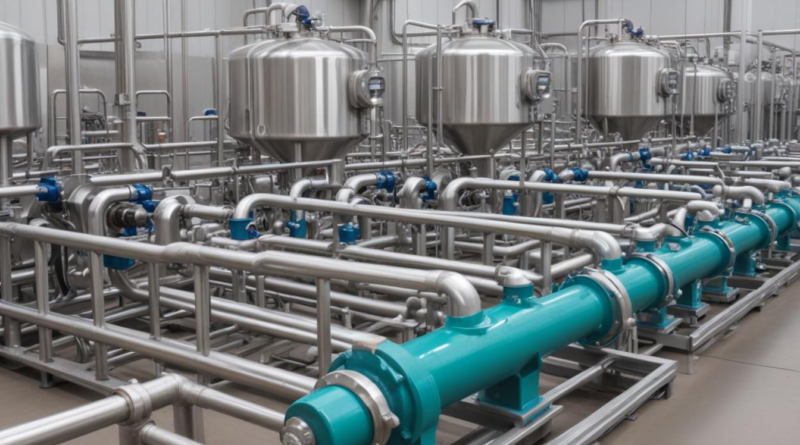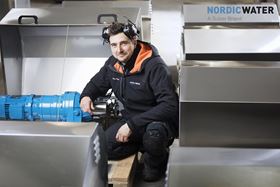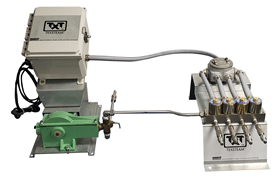pumps used in the food safety industry
Various types of pumps are integral to maintaining efficiency and compliance within the food safety industry. Each pump type offers distinct advantages tailored to specific applications, ensuring the integrity and safety of food products throughout processing.
Centrifugal Pumps are widely utilized due to their simplicity and ability to handle large volumes of liquid with low viscosity. They operate by converting rotational energy into kinetic energy, making them ideal for applications such as transferring water, juices, and other aqueous solutions in food processing facilities.
Positive Displacement Pumps provide precise flow control, which is essential for applications requiring accurate dosing and consistency. These pumps operate by trapping a fixed amount of fluid and forcing it through the system, minimizing pulsation and ensuring steady delivery. Common types within this category include:
- Gear Pumps: Suitable for handling thick or viscous liquids like syrups and oils, gear pumps offer reliable performance with minimal maintenance.
- Diaphragm Pumps: Ideal for pumping abrasive or shear-sensitive liquids, diaphragm pumps ensure gentle handling without compromising flow rates.
Peristaltic Pumps excel in applications that demand high levels of hygiene and contamination prevention. By using a rotating mechanism to compress a flexible tube, these pumps facilitate sterile fluid transfer, making them perfect for pharmaceutical-grade food processing and aseptic packaging.
Progressive Cavity Pumps are characterized by their ability to handle highly viscous and shear-sensitive products without degrading them. This makes them suitable for applications involving dough, purees, and other similar food products where maintaining texture and consistency is crucial.
Hygienic Pumps are specifically designed to meet strict sanitation standards required in the food safety industry. Constructed from materials that resist corrosion and bacterial growth, these pumps ensure that food products remain uncontaminated during transfer and processing.
| Pump Type | Key Features | Common Applications |
|---|---|---|
| Centrifugal Pumps | High flow rates, low maintenance | Water transfer, juice processing |
| Gear Pumps | Handles viscous liquids, reliable | Syrup and oil handling |
| Diaphragm Pumps | Precise flow control, gentle handling | Abrasive liquid transfer, dosing |
| Peristaltic Pumps | High hygiene standards, sterile transfer | Pharmaceutical-grade processing, aseptic packaging |
| Progressive Cavity Pumps | Handles highly viscous products, maintains texture | Dough, purees, thick sauces |
| Hygienic Pumps | Corrosion-resistant, easy to clean | Contamination-sensitive food transfers |
Selecting the appropriate pump type is crucial for optimizing process efficiency, ensuring compliance with food safety pumps standards, and maintaining the quality of food products throughout their journey in the processing and packaging stages.
regulatory compliance
Ensuring adherence to regulatory standards is crucial for maintaining the safety and integrity of food products throughout the processing stages. Compliance with relevant regulations not only safeguards public health but also enhances the reputation and reliability of food processing operations.
Key Regulatory Bodies and Standards
- Food and Drug Administration (FDA): The FDA establishes comprehensive guidelines that govern the materials and design of pumps to prevent chemical and microbial contamination. Compliance with FDA regulations ensures that pumps are safe for direct contact with food products.
- United States Department of Agriculture (USDA): For facilities involved in meat and poultry processing, USDA regulations mandate stringent cleanliness and safety standards. Pumps used in these applications must meet specific requirements to prevent contamination and ensure hygienic processing.
- European Hygienic Engineering & Design Group (EHEDG): EHEDG focuses on hygienic design principles that promote easy cleaning and maintenance of equipment. Adhering to EHEDG standards helps in minimizing bacterial growth and ensuring the sanitary integrity of pump systems.
- NSF International: NSF certification verifies that pumps meet public health standards, particularly regarding materials compatibility and sanitation. Pumps bearing NSF marks have undergone rigorous testing to ensure they are free from harmful contaminants and suitable for food processing applications.
Material and Design Compliance
Pumps must be constructed from materials approved for food contact, such as stainless steel grades 304 or 316, which offer exceptional resistance to corrosion and ease of sanitation. The design of pumps should minimize crevices and dead-legs where bacteria can accumulate, facilitating effective cleaning and reducing the risk of contamination.
| Regulatory Body | Focus Area | Relevant Standards |
|---|---|---|
| FDA | Material safety, design for cleanliness | 21 CFR Part 177, 178 |
| USDA | Meat and poultry processing standards | USDA FSIS regulations |
| EHEDG | Hygienic design | EHEDG Guidelines 03, 04 |
| NSF International | Public health standards | NSF/ANSI 61, 3 |
Compliance Strategies
To maintain regulatory compliance, organizations should implement the following strategies:
- Regular Audits: Conduct frequent inspections and audits to ensure that pump systems consistently meet regulatory standards.
- Proper Documentation: Maintain detailed records of compliance certifications, maintenance activities, and cleaning protocols to demonstrate adherence to regulations.
- Validated Cleaning Protocols: Develop and follow standardized cleaning procedures that are validated to effectively remove contaminants and prevent microbial growth.
- Employee Training: Train personnel on regulatory requirements and best practices for maintaining compliance in pump operations and maintenance.
Manufacturers of food safety pumps often provide comprehensive compliance documentation and certifications, ensuring that their products are suitable for various applications within the food processing industry. By selecting pumps that meet these stringent regulatory requirements, food processing facilities can achieve higher standards of hygiene, reduce the risk of contamination, and ensure the consistent quality of their food products.
sanitation and maintenance
Maintaining impeccable sanitation and rigorous maintenance schedules is paramount for ensuring the reliability and safety of pumps within the food safety industry. Effective sanitation practices prevent microbial contamination, while regular maintenance ensures optimal performance and longevity of the equipment.
Sanitation Practices
Implementing stringent sanitation protocols is essential to uphold hygiene standards and comply with regulatory requirements. Key practices include:
- Cleaning-In-Place (CIP): This automated process allows for thorough cleaning of pump systems without disassembly. CIP involves circulating cleaning agents through the pump to remove residues and contaminants efficiently.
- Manual Cleaning: For components that cannot be cleaned using CIP, manual cleaning procedures must be established. This involves disassembling parts and using appropriate cleaning agents to ensure complete removal of food residues.
- Sanitizing Agents: Selecting appropriate sanitizers, such as chlorine-based or hydrogen peroxide solutions, is crucial. These agents must be compatible with pump materials and effective against a broad spectrum of microorganisms.
- Scheduled Cleaning: Establishing a regular cleaning schedule based on the pump’s usage and the nature of the processed products ensures consistent hygiene levels and minimizes contamination risks.
Maintenance Strategies
A proactive maintenance approach helps in identifying potential issues before they escalate, ensuring uninterrupted operation and compliance with food safety standards. Key strategies include:
- Preventive Maintenance: Regularly scheduled inspections and servicing of pumps help in detecting wear and tear, lubricating moving parts, and replacing worn components. This reduces the likelihood of unexpected failures and extends the lifespan of the equipment.
- Predictive Maintenance: Utilizing advanced monitoring techniques, such as vibration analysis and thermal imaging, allows for the prediction of maintenance needs based on the actual condition of the pump. This approach minimizes downtime and optimizes maintenance resources.
- Corrective Maintenance: Addressing issues as they arise is critical for maintaining operational efficiency. Promptly repairing or replacing faulty parts ensures that pumps continue to function correctly and do not compromise food safety.
- Documentation and Record-Keeping: Maintaining detailed records of all maintenance activities, including inspections, repairs, and part replacements, is essential for compliance audits and tracking the pump’s performance over time.
Best Practices for Sanitation and Maintenance
Adhering to best practices ensures that pumps remain in optimal condition and compliant with food safety standards. These practices include:
- Material Compatibility: Ensure that cleaning and sanitizing agents are compatible with pump materials to prevent corrosion and degradation. Using non-abrasive cleaning tools can also minimize wear on pump surfaces.
- Training and Education: Providing comprehensive training to maintenance personnel on proper cleaning techniques, maintenance procedures, and safety protocols is vital for maintaining high standards of hygiene and equipment performance.
- Regular Audits and Inspections: Conducting routine audits and inspections helps in verifying that sanitation and maintenance procedures are being followed correctly and effectively. This also aids in identifying areas for improvement.
- Use of High-Quality Components: Investing in high-quality seals, gaskets, and other critical components reduces the frequency of replacements and enhances the overall reliability of the pump system.
| Sanitation Activity | Description | Frequency |
|---|---|---|
| Cleaning-In-Place (CIP) | Automated cleaning of pump internals using cleaning agents | Daily |
| Lubrication | Applying lubricants to moving parts to reduce friction | Weekly |
| Component Inspection | Checking seals, gaskets, and bearings for wear and tear | Monthly |
| Sanitizing | Applying sanitizing agents to pump surfaces to eliminate pathogens | After each cleaning cycle |
| Performance Testing | Assessing pump efficiency and flow rates to ensure optimal operation | Quarterly |
Challenges and Solutions
Maintaining sanitation and performing regular maintenance on food safety pumps can present several challenges. Addressing these proactively ensures sustained compliance and performance.
- Contamination Risks: Ensuring that all cleaning agents are thoroughly rinsed to prevent chemical residues is essential. Implementing effective CIP protocols can mitigate this risk.
- Downtime Minimization: Coordinating maintenance activities during non-production hours reduces the impact on operations. Predictive maintenance techniques also help in scheduling repairs before failures occur.
- Access to Components: Designing pumps with easy access to critical components facilitates quicker cleaning and maintenance, reducing both labor and time requirements.
- Compliance Documentation: Keeping accurate and up-to-date records requires efficient data management systems. Utilizing digital maintenance management software can streamline this process.
By prioritizing sanitation and maintenance, food processing facilities can ensure that their pump systems operate efficiently, maintain the highest hygiene standards, and comply with all relevant regulations. This not only protects consumer health but also upholds the integrity and reputation of the food safety industry.
materials and construction
 Selecting the appropriate materials for pump construction is critical in the food safety industry, where hygiene, durability, and compliance with regulatory standards are paramount. The choice of materials directly influences the pump’s ability to maintain sanitary conditions, resist corrosion, and withstand the demanding environments typical of food processing applications.
Selecting the appropriate materials for pump construction is critical in the food safety industry, where hygiene, durability, and compliance with regulatory standards are paramount. The choice of materials directly influences the pump’s ability to maintain sanitary conditions, resist corrosion, and withstand the demanding environments typical of food processing applications.
Common Materials Used
- Stainless Steel: Stainless steel is the most prevalent material in food safety pumps due to its excellent resistance to corrosion, ease of cleaning, and ability to withstand high temperatures. Grades 304 and 316 are particularly favored, with grade 316 offering superior resistance to chloride-induced corrosion, making it ideal for environments where exposure to salt or acidic substances is common.
- Food-Grade Plastics: Polymers such as polyethylene (PE), polypropylene (PP), and polyvinylidene fluoride (PVDF) are widely used in pump components. These materials offer chemical resistance, lightweight properties, and are suitable for applications requiring flexibility and non-reactivity with food products.
- Silicone and Rubber: Flexible materials like silicone and food-grade rubber are essential for seals and gaskets, ensuring leak-proof connections and accommodating thermal expansion without compromising sanitary conditions.
- Bronze and Brass: These materials are occasionally used for specific components due to their machinability and antimicrobial properties, although they are less common in primary pump structures compared to stainless steel.
Design Considerations
The construction of food safety pumps involves several design principles aimed at minimizing contamination risks and facilitating easy maintenance:
- Seamless Construction: Pumps are often manufactured with seamless or welded joints to eliminate crevices and dead-legs where bacteria can harbor. This design ensures a smooth internal surface that is easier to clean and sanitize.
- Minimal Crevices: Designing pump components with smooth, continuous surfaces reduces the number of nooks and crannies, decreasing the likelihood of microbial accumulation.
- Sanitary Fittings: Incorporating sanitary flange connections and hygienic seals ensures that all points of connection are leak-proof and easy to disassemble for cleaning purposes.
- Easy Disassembly: Pumps are designed for quick and straightforward disassembly, allowing for comprehensive cleaning and inspection without extensive downtime.
Material Compatibility
Ensuring compatibility between pump materials and the fluids being processed is essential to prevent chemical degradation and maintain sanitary conditions. Compatibility considerations include:
- Chemical Resistance: Materials must resist corrosion and degradation when exposed to various food products, acids, alkalis, and cleaning agents used in the sanitation process.
- Temperature Tolerance: Components must withstand the operating temperatures required for different food processing applications, ranging from chilled environments to high-temperature pasteurization processes.
- Mechanical Strength: Materials should maintain structural integrity under the pressures and flow rates typical of the specific pump type and application.
Table: Common Materials and Their Properties
| Material | Properties | Common Applications |
|---|---|---|
| Stainless Steel 304 | Good corrosion resistance, easy to clean | General liquid transfer, juice processing |
| Stainless Steel 316 | Superior corrosion resistance, especially to chlorides | Seafood processing, acidic product handling |
| Polypropylene (PP) | Lightweight, chemical resistant | Low-viscosity liquid pumping, dairy applications |
| Polyvinylidene Fluoride (PVDF) | High chemical resistance, durable | Syrup and oil handling, specialized food applications |
| Silicone | Flexible, temperature resistant | Seals and gaskets in sanitary pumps |
Advanced Construction Techniques
Modern food safety pumps incorporate advanced construction techniques to enhance performance and hygiene:
- Welded Fabrication: Utilizing automated welding processes ensures consistent, high-quality joints that are free from defects, reducing the risk of leaks and contamination.
- Casting and Molding: Precision casting and injection molding allow for the creation of complex geometries with smooth finishes, facilitating easy cleaning and assembly.
- Modular Design: Modular pump designs enable easy replacement of individual components, simplifying maintenance and minimizing downtime.
Quality Assurance and Testing
Ensuring that materials and construction methods meet the highest standards is vital for maintaining the integrity of food safety pumps:
- Material Certification: Suppliers provide material certifications to verify that all components meet FDA and other relevant standards for food contact.
- Non-Destructive Testing (NDT): Techniques such as ultrasonic testing and radiography are employed to detect internal defects in pump components, ensuring structural integrity.
- Surface Finish Standards: Adhering to specific surface roughness standards (e.g., Ra < 0.8 µm) ensures that pump surfaces are smooth enough to prevent bacterial adherence and facilitate cleaning.
Sustainable Materials and Eco-Friendly Practices
In addition to hygiene and durability, there is a growing emphasis on sustainability in pump materials and construction practices:
- Recyclable Materials: Utilizing materials that can be recycled at the end of the pump’s lifecycle reduces environmental impact.
- Energy-Efficient Manufacturing: Implementing energy-efficient processes in the manufacturing of pump components minimizes the carbon footprint.
- Long-Lasting Designs: Designing pumps with durable materials and robust construction extends their operational lifespan, reducing the need for frequent replacements and conserving resources.
By meticulously selecting materials and employing advanced construction techniques, manufacturers can produce food safety pumps that not only meet stringent hygiene and regulatory standards but also deliver reliable performance across various applications in the food processing industry. This commitment to quality and precision ensures the safety and integrity of food products from production to packaging.
applications in food processing
In the dynamic landscape of food processing, pumps play a pivotal role in ensuring efficient, safe, and consistent operations. Their versatility allows them to be integral components across various stages of food production, from raw material handling to final packaging. Understanding the specific applications of different pump types within the industry is essential for optimizing process efficiency and maintaining product integrity.
Dairy Processing
Dairy processing involves handling a range of liquids with varying viscosities and temperatures. Pumps in this sector must maintain sanitary conditions to prevent contamination and preserve the quality of dairy products.
- Centrifugal Pumps: Commonly used for transferring milk, cream, and whey due to their ability to handle large volumes efficiently.
- Positive Displacement Pumps: Utilized for precise dosing of additives and enzymes, ensuring consistency in product formulation.
- Peristaltic Pumps: Ideal for sterile transfer of milk and other dairy liquids, minimizing the risk of contamination.
Beverage Production
The beverage industry demands high hygiene standards and precise flow control to maintain product quality. Pumps facilitate the movement of liquids through various stages, including mixing, carbonation, and bottling.
- Peristaltic Pumps: Preferred for their hygienic design, allowing for sterile transfer of beverages without direct contact with pump components.
- Gear Pumps: Used for handling thick syrups and flavorings, providing consistent flow rates essential for uniform taste distribution.
- Diaphragm Pumps: Employed in carbonation processes where precise pressure control is necessary to infuse CO2 into beverages.
Meat and Poultry Processing
In meat and poultry processing, pumps are essential for tasks such as marinating, brining, and transferring viscous products. These applications require pumps that can handle both liquids and semi-solids while maintaining hygiene standards.
- Progressive Cavity Pumps: Ideal for moving thick marinades and brines, ensuring even distribution and minimal product degradation.
- Hygienic Centrifugal Pumps: Used for transferring water and liquid additives, designed to prevent microbial contamination.
- Diaphragm Pumps: Suitable for precise dosing of preservatives and flavorings, maintaining product consistency.
Baking and Confectionery
The baking and confectionery sectors require pumps that can handle a variety of textures, from liquid doughs to thick chocolate syrups. Maintaining the consistency and quality of these products is crucial.
- Peristaltic Pumps: Employed for transferring chocolate and other viscous syrups, ensuring smooth and contamination-free flow.
- Gear Pumps: Used for moving dough and batter, providing the necessary torque to handle high-viscosity materials without introducing air bubbles.
- Progressive Cavity Pumps: Ideal for thick doughs, enabling consistent product movement without altering texture.
Frozen and Chilled Food Processing
Handling frozen and chilled products requires pumps that can operate efficiently at low temperatures while preventing thawing and maintaining product integrity.
- Centrifugal Pumps: Utilized for transferring ice cream mix and other frozen liquids, designed to prevent ice formation within the pump system.
- Positive Displacement Pumps: Employed for precise dosing of flavorings and additives in frozen desserts, ensuring uniform distribution.
- Hygienic Pumps: Essential for maintaining sanitary conditions during the transfer of chilled products, minimizing the risk of bacterial growth.
Fermentation and Biotechnology
In fermentation processes, maintaining sterile conditions and precise flow control is critical to ensuring product quality and safety. Pumps facilitate the movement of culture media, nutrients, and final products.
- Peristaltic Pumps: Preferred for sterile transfer in fermentation tanks, preventing contamination by isolating the fluid from pump components.
- Diaphragm Pumps: Used for controlling the addition of nutrients and other additives, ensuring precise flow rates essential for optimal fermentation.
- Progressive Cavity Pumps: Employed for moving viscous fermentation broths, maintaining consistent flow without shear stress on microbial cultures.
Packaging and Filling
Efficient packaging and filling processes rely on pumps to accurately dispense liquids into containers, ensuring consistency and minimizing waste.
- Gear Pumps: Utilized for metering and distributing precise volumes of liquids into packaging containers, ensuring uniform filling.
- Positive Displacement Pumps: Employed for high-viscosity products, providing consistent flow rates necessary for accurate filling.
- Peristaltic Pumps: Ideal for sanitary filling applications, enabling easy cleaning and preventing contamination during the packaging process.
Table: Applications of Pumps in Food Processing
| Food Processing Sector | Common Pump Types | Primary Functions |
|---|---|---|
| Dairy Processing | Centrifugal, Positive Displacement, Peristaltic Pumps | Milk transfer, precise dosing, sterile liquid handling |
| Beverage Production | Peristaltic, Gear, Diaphragm Pumps | Sterile transfer, syrup handling, carbonation control |
| Meat and Poultry Processing | Progressive Cavity, Hygienic Centrifugal, Diaphragm Pumps | Marinating, brining, additive dosing |
| Baking and Confectionery | Peristaltic, Gear, Progressive Cavity Pumps | Chocolate transfer, dough handling, syrup dispensing |
| Frozen and Chilled Food Processing | Centrifugal, Positive Displacement, Hygienic Pumps | Frozen liquid transfer, additive dosing, sanitary handling |
| Fermentation and Biotechnology | Peristaltic, Diaphragm, Progressive Cavity Pumps | Sterile transfer, nutrient addition, broth movement |
| Packaging and Filling | Gear, Positive Displacement, Peristaltic Pumps | Liquid dispensing, precise filling, sanitary packaging |
Innovative Applications
Beyond traditional uses, pumps in the food safety industry are continually evolving to meet emerging needs and technological advancements.
- Automated Systems: Integration of pumps with automated control systems allows for real-time monitoring and adjustment of flow rates, enhancing process efficiency and reducing human error.
- Smart Pumps: Equipped with sensors and IoT capabilities, smart pumps provide predictive maintenance alerts and performance analytics, ensuring uninterrupted operations.
- Sustainable Practices: Energy-efficient pump designs and the use of recyclable materials contribute to sustainable food processing practices, aligning with industry trends towards eco-friendly operations.
The strategic deployment of various types of pumps across different applications in the food processing industry underscores their critical role in maintaining food safety, operational efficiency, and product quality. By selecting the appropriate pump for each specific application, food processing facilities can enhance their production capabilities, ensure compliance with stringent hygiene standards, and deliver superior products to consumers.




